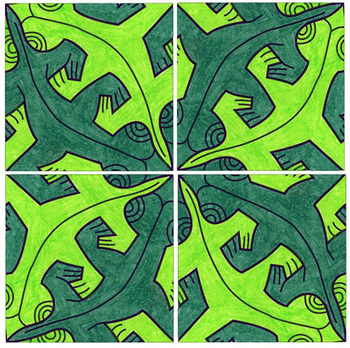

The difficulty of tasks can be varied in many ways including: providing opportunities for students to work collaboratively in partnerships, and to share and justify their ideas in small groups, and with the whole class.providing teacher support with the drawing of tessellations.directly modelling examples of tessellations and transformations.asking students to justify why they believe tessellating patterns occur.providing physical manipulatives, regular polygons, or online tools (many are available), so that students can experiments with the tessellation and transformation of different shapes.The learning opportunities in this unit can be differentiated by providing or removing support to students and by varying the task requirements. Ways to differentiate include: Explore and use art-making conventions, applying knowledge of elements and selected principles through the use of materials and processes.Investigate the purpose of objects and images from past and present cultures and identify the contexts in which they were or are made, viewed, and valued.Main resource: Creating Escher-Type Drawings. The idea of this unit is for students to develop their understanding of the mathematical concepts that underlie the creation of Escher type tessellations and apply this to the creation of an art piece. You might use the ideas from Measuring Angles, Level 3 for this purpose. Note that this unit does not include explicit teaching around angles, although this could be included as an additional point of learning. Either the corners of the basic shape all fit together to make 360°, or the corners of some basic shapes fit together along the side of another to again make 360°. This requires the vertices to fit together. The same figure (or group of figures) come together to completely cover a wall or floor or some other plane. The key features of tessellations are that there are no gaps or overlaps. These tessellations provide a strong structure for their two different purposes. The brick wall provides a tessellation with rectangles and the honeycomb is a tessellation of regular hexagons. Bees use a basic hexagonal shape to manufacture their honeycombs. Brick walls are made of the same shaped brick repeatedly laid in rows. They also provide a nice application of some of the basic properties of polygons. Tessellations are a neat and symmetric form of decoration.

Occasionally you can see them in the living room as the basis of the pattern on carpets and in parquetry wooden floors. Tessellations are found all over the place but especially in the kitchen and bathroom on tiles and lino. The unit of work is based on the work of the Dutch artist Escher who utilised mathematical concepts, including tessellation, to create mathematically pieces of artwork.


 0 kommentar(er)
0 kommentar(er)
